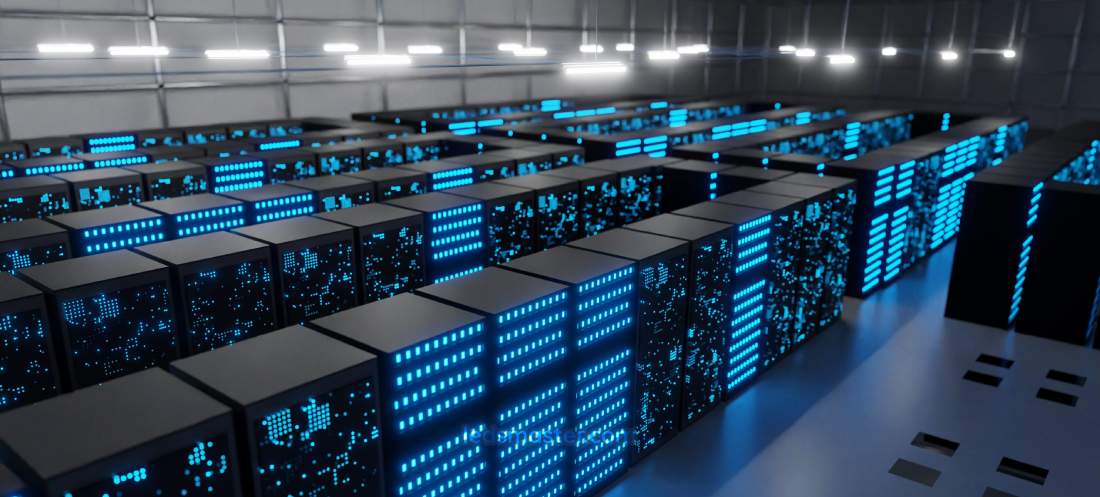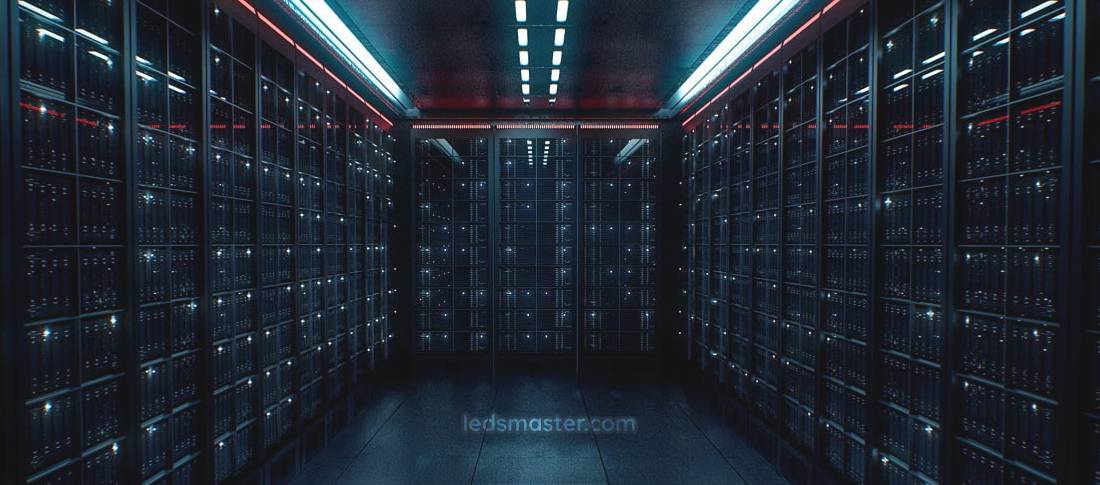Light up your data center with precision and efficiency using our cutting-edge Data Center Lighting solutions. Designed to optimize visibility while minimizing energy consumption, our products ensure a well-lit environment conducive to peak performance and operational excellence.
Experience superior lighting durability and efficiency for your data center with our state-of-the-art Data Center Lighting solutions. Engineered to withstand continuous 24/7 operation, our products ensure reliable illumination while optimizing energy usage. Create an environment that enhances performance and operational excellence with our advanced lighting technology.
Get your complimentary lighting design today
Table of Contents
ToggleData centers are the backbone of our digital world, housing the servers and networking equipment that power the internet and various applications. As technology advances, so do the requirements for efficiency and reliability within these facilities. One crucial aspect of maintaining optimal operations is the lighting system. The evolution of LED lighting in data centers has transformed how these facilities are designed and operated, offering significant benefits over traditional lighting technologies.
Lighting in data centers is not just about visibility; it plays a vital role in ensuring safety, productivity, and operational efficiency. The right lighting conditions allow staff to navigate complex environments safely, perform maintenance tasks effectively, and respond quickly to any issues that may arise. With the increasing demand for 24/7 operations and high uptime, the importance of a reliable and efficient lighting system cannot be overstated.
Traditional lighting options, such as fluorescent and incandescent bulbs, often fail to meet the demanding needs of data centers. These older technologies come with a range of challenges. For one, conventional lights may burn out unexpectedly, leading to operational disruptions and requiring costly replacements. High maintenance costs are another significant drawback, as regular maintenance is necessary to ensure consistent performance, which can divert resources from critical tasks. Moreover, traditional lighting consumes more energy, resulting in higher operational costs and a larger carbon footprint.

LED (Light Emitting Diode) technology has emerged as a game-changer in the lighting industry, particularly in data centers. The advantages of LED lights over traditional lighting options are numerous and impactful. They are specifically designed to endure the challenges presented by data centers. Unlike traditional lighting options, which may fail or require frequent maintenance, LED lights are known for their superior durability.
LED lights are constructed from robust materials that can withstand the rigors of data center environments. They can handle temperature extremes that data centers generate and operate efficiently in a range of temperatures without performance degradation. Additionally, the solid-state design of LEDs makes them less susceptible to damage from vibrations and impacts, ensuring longer lifespans.
This reliability translates into reduced operational disruptions, allowing data center personnel to focus on their tasks rather than worrying about lighting failures. The longevity of LEDs means that replacements are less frequent, contributing to lower lifecycle costs and ensuring operational continuity. Many LED fixtures have lifespans of up to 50,000 hours or more, significantly outpacing traditional bulbs. The reduced need for replacements not only lowers maintenance costs but also minimizes the environmental impact associated with disposing of old lighting fixtures.
Furthermore, LED lighting fixtures require minimal maintenance, which is particularly beneficial in data centers where every minute of downtime can have financial repercussions. By minimizing maintenance requirements, data centers can redirect resources toward critical operations, ensuring optimal productivity.
Data centers operate continuously, necessitating lighting solutions that can perform reliably under constant use. Lighting infrastructure must support uninterrupted operation without sacrificing efficiency or quality. LED lights excel in this regard, providing consistent illumination levels throughout their lifespan.

Unlike conventional lights that may dim over time, LEDs maintain their brightness, ensuring optimal visibility for data center personnel at any hour. This unwavering reliability enhances the overall resilience of the data center, aligning perfectly with the industry’s stringent uptime requirements.
Adequate lighting levels are crucial for navigating the facility safely, conducting maintenance tasks effectively, and responding to any issues without being hampered by inadequate lighting. Proper lighting levels help prevent accidents and promote a safe working environment, which is crucial in facilities that handle sensitive data and equipment.
Efficiency lies at the core of modern data center operations, and lighting plays a crucial role in energy consumption within these facilities. Traditional lighting technologies often consume more power and have shorter lifespans, leading to higher operational costs.
In contrast, LED lighting solutions are not only durable but also highly energy-efficient. They consume significantly less power while delivering equal or better light output, resulting in reduced electricity bills and a lower environmental footprint. The energy savings from switching to LED lighting can be substantial, allowing data centers to allocate funds more effectively toward growth and innovation.
The impact of energy optimization goes beyond mere cost savings. Advanced lighting controls, such as dimming and occupancy sensing, enhance energy efficiency by dynamically adjusting light levels based on real-time needs. For instance, lights can automatically dim or turn off in unoccupied areas, maximizing energy usage while ensuring safety and security. This intelligent approach to lighting supports the overarching goal of minimizing energy consumption without compromising operational requirements.
The integration of advanced control systems elevates the functionality and adaptability of data center lighting solutions.
These systems enable operators to manage and monitor lighting remotely, allowing for precise adjustments that meet varying operational demands. The ability to adjust lighting in real time contributes to an efficient workflow, as operators can respond to changes in occupancy or operational needs without delay.
Intelligent lighting systems can also provide valuable data analytics capabilities, offering insights into energy consumption patterns. This information can inform ongoing efficiency improvements across the data center infrastructure. By understanding how and when lighting is used, operators can make informed decisions that enhance the overall energy efficiency of the facility.
Furthermore, these advanced control systems often support integration with other smart building technologies, creating a cohesive environment that prioritizes efficiency. The ability to adapt lighting to the specific needs of the data center not only enhances operational flexibility but also supports sustainability initiatives.
As data centers increasingly integrate IoT devices and automation, lighting systems must be able to connect and communicate with other technologies. This interconnectedness allows for a holistic approach to facility management, optimizing performance across various systems and functions.
Beyond efficiency and reliability, data center lighting must adhere to stringent safety standards to ensure the well-being of personnel and operational integrity.
Adequate lighting levels are crucial for navigating the facility safely and performing maintenance tasks effectively. Insufficient lighting can lead to accidents or errors, potentially compromising both personnel safety and equipment integrity. LED lighting meets regulatory requirements for illumination levels and color rendering, providing a safer working environment.
The quality of light emitted by LEDs supports accurate color differentiation, which is particularly important in environments where precise visual tasks are performed. Additionally, LEDs emit minimal heat and contain no hazardous materials, contributing to both safety and environmental sustainability within the data center environment.
The commitment to safety extends beyond compliance; it is also about fostering a culture of well-being within the workplace. Adequate lighting ensures that employees can perform their tasks comfortably and efficiently, reducing the risk of fatigue and errors associated with poor visibility.
As data centers evolve to meet increasing demands and technological advancements, lighting solutions must be adaptable to ensure they remain relevant and effective.
Scalability is crucial, allowing operators to expand or modify lighting systems seamlessly as the facility grows or undergoes upgrades. Modular lighting designs offer the flexibility needed for future expansion, allowing data center operators to implement new technologies without overhauling entire systems.
This adaptability is vital in an industry characterized by rapid change and the need for continuous improvement. Lighting solutions that can evolve alongside the data center not only enhance operational flexibility but also extend the lifespan of lighting investments, delivering long-term value and reliability.
As data centers increasingly adopt new technologies, the ability to integrate lighting systems with smart building technologies will be essential. This ensures that lighting solutions remain effective as operational needs change, maximizing both efficiency and sustainability.
Sustainability has become a paramount consideration for data centers as they seek to minimize their environmental impact.
The choice of lighting solutions plays a significant role in achieving sustainability goals. LED lighting, known for its energy efficiency, contributes to reduced carbon emissions and aligns with broader environmental initiatives.
Moreover, the longevity and durability of LED lights mean fewer replacements, reducing waste associated with discarded lighting fixtures. The focus on sustainability extends beyond energy consumption; it encompasses the entire lifecycle of lighting products, from production to disposal. Selecting lighting solutions that are environmentally friendly and recyclable aligns with the growing emphasis on sustainable practices in the data center industry.
Data centers can further enhance their sustainability efforts by implementing smart lighting controls and monitoring systems. By analyzing usage patterns and adjusting lighting accordingly, operators can significantly reduce energy consumption and contribute to a greener future.
Data center lighting serves a fundamental role in operational efficiency, reliability, and sustainability. LED technology has emerged as the leading choice for data center lighting solutions, offering durability, energy efficiency, and versatility.
The integration of advanced control systems and adherence to stringent safety and regulatory standards optimize operational performance and facilitate sustainable growth in the data center industry.
As data centers continue to evolve as technological nerve centers in the digital age, investing in robust and efficient lighting infrastructure remains vital for achieving optimal outcomes. The focus on durability, reliability, and adaptability in lighting solutions positions data centers for success in a rapidly changing landscape, ensuring they can meet the challenges of tomorrow while maintaining a competitive edge.
With the ongoing advancements in LED technology and the growing importance of sustainability, the future of data center lighting looks promising. As organizations continue to prioritize efficiency and safety, LED lighting will undoubtedly play a pivotal role in shaping the data center of the future.